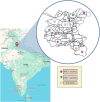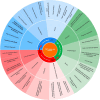Community-based palliative care needs and barriers to access among cancer patients in rural north India: a Participatory action research
- PMID: 39385265
- PMCID: PMC11462709
- DOI: 10.1186/s12904-024-01572-7
Community-based palliative care needs and barriers to access among cancer patients in rural north India: a Participatory action research
Erratum in
-
Correction: Community-based palliative care needs and barriers to access among cancer patients in rural north India: a Participatory action research.BMC Palliat Care. 2024 Nov 7;23(1):258. doi: 10.1186/s12904-024-01591-4. BMC Palliat Care. 2024. PMID: 39511584 Free PMC article. No abstract available.
Abstract
Background: This paper aimed to explore the palliative care (PC) needs and barriers to access among cancer patients in a rural region of North India with a high cancer burden.
Methods: A Participatory action research (PAR) approach was employed. Situational assessment, community sensitization workshops (CSWs) and door-to-door surveys were planned, conducted and developed over three PAR cycles. A parallel convergent mixed-methods approach was adopted wherein the quantitative data from door-to-door surveys and qualitative data from CSWs and investigator field notes were collected and analyzed to provide a comprehensive understanding of PC needs and barriers to access. Descriptive statistics and thematic analysis were used.
Results: A total of 27 CSWs involving 526 stakeholders were conducted. A total of 256 cancer patients were assessed for PC needs and symptom burden using the Supportive and Palliative Care Indicators (SPICT-4ALL) and the Edmonton Symptom Assessment System (ESAS) tool, respectively. Based on the SPICT assessment, all patients (n = 256) satisfied general and/or cancer-specific indicators for PC. The majority (56.6%) had ≥ one moderate-severe symptom, with the most common symptoms being tiredness, pain and loss of appetite. Analysis of qualitative findings generated three themes: unmet needs, burden of caregiving, and barriers and challenges. Cancer affected all domains of patients' and their families' lives, contributing to biopsychosocial suffering. Social stigma, discrimination, sympathizing attitudes and lack of emotional and material support contributed to psychosocial suffering among cancer patients and their caregivers. Lack of awareness, nearby healthcare facilities, transportation, essential medicines, trained manpower and education in PC, collusion, fear of social discrimination, faulty perceptions and misconceptions about cancer made access to PC difficult.
Conclusions: The study emphasize the need for and provide a roadmap for developing context-specific and culturally appropriate CBPC services to address the identified challenges and needs. The findings point towards education of CHWs in PC; improving community awareness about cancer, PC, government support schemes; ensuring an uninterrupted supply of essential medicines; and developing active linkages within the community and with NGOs to address the financial, transportation, educational, vocational and other social needs as some of the strategies to ensure holistic CBPC services.
Trial registration: Clinical Trial Registry of India (CTRI/2023/04/051357).
Keywords: Cancer; Community; North India; Palliative care; Participatory action research; Rural.
© 2024. The Author(s).
Conflict of interest statement
The authors declare no competing interests.
Figures
Similar articles
-
Multilevel model of stigma and barriers to cancer palliative care in India: a qualitative study.BMJ Open. 2019 Mar 4;9(3):e024248. doi: 10.1136/bmjopen-2018-024248. BMJ Open. 2019. PMID: 30837250 Free PMC article.
-
Determinants and Experiences of Care-Seeking for Childhood Pneumonia in a Rural Indian Setting: A Mixed-Methods Study.Health Expect. 2025 Apr;28(2):e70263. doi: 10.1111/hex.70263. Health Expect. 2025. PMID: 40238635 Free PMC article.
-
Symptom burden among Northern Alberta radiotherapy patients with advanced cancer: mapping needs and gaps.Support Care Cancer. 2020 Oct;28(10):4963-4969. doi: 10.1007/s00520-020-05330-2. Epub 2020 Feb 7. Support Care Cancer. 2020. PMID: 32034512
-
The benefits, barriers, and specific needs of palliative care for adults with cancer in sub-Saharan Africa: a systematic review.Glob Health Action. 2025 Dec;18(1):2485742. doi: 10.1080/16549716.2025.2485742. Epub 2025 Apr 10. Glob Health Action. 2025. PMID: 40208058 Free PMC article.
-
Examining Barriers and Facilitators to Palliative Care Access in Rural Areas: A Scoping Review.Am J Hosp Palliat Care. 2022 Jan;39(1):123-130. doi: 10.1177/10499091211011145. Epub 2021 Apr 28. Am J Hosp Palliat Care. 2022. PMID: 33906486
Cited by
-
End-of-life care in rural China: the crucial role and challenges of village doctors.BMC Palliat Care. 2025 Apr 25;24(1):115. doi: 10.1186/s12904-025-01755-w. BMC Palliat Care. 2025. PMID: 40281517 Free PMC article.
-
The Role of Yoga in Palliative Care: Insights From a Single Case Study.Cureus. 2025 May 12;17(5):e83993. doi: 10.7759/cureus.83993. eCollection 2025 May. Cureus. 2025. PMID: 40510100 Free PMC article.
-
Correction: Community-based palliative care needs and barriers to access among cancer patients in rural north India: a Participatory action research.BMC Palliat Care. 2024 Nov 7;23(1):258. doi: 10.1186/s12904-024-01591-4. BMC Palliat Care. 2024. PMID: 39511584 Free PMC article. No abstract available.
-
Barriers and facilitators to palliative care service utilization in Ethiopia: A qualitative systematic review, 2025.PLoS One. 2025 Aug 4;20(8):e0328222. doi: 10.1371/journal.pone.0328222. eCollection 2025. PLoS One. 2025. PMID: 40758698 Free PMC article.
References
-
- Wang H, Naghavi M, Allen C, Barber RM, Bhutta ZA, Carter A, et al. Global, regional, and national life expectancy, all-cause mortality, and cause-specific mortality for 249 causes of death, 1980–2015: a systematic analysis for the global burden of disease study 2015. Lancet. 2016;388(10053):1459–544 Available from: https://linkinghub.elsevier.com/retrieve/pii/S0140673616.... - PMC - PubMed
-
- Sung H, Ferlay J, Siegel RL, Laversanne M, Soerjomataram I, Jemal A, et al. Global cancer statistics 2020: GLOBOCAN estimates of incidence and mortality worldwide for 36 cancers in 185 countries. CA Cancer J Clin. 2021;71(3):209–49. - PubMed
-
- Fitzmaurice C, Abate D, Abbasi N, Abbastabar H, Abd-Allah F, Abdel-Rahman O, et al. Global, regional, and national cancer incidence, mortality, years of life lost, years lived with disability, and disability-adjusted life-years for 29 cancer groups, 1990 to 2017: a systematic analysis for the global burden of disease study. JAMA Oncol. 2019;5(12):1749–68. - PMC - PubMed
-
- Palliative care. Available from: https://www.who.int/news-room/fact-sheets/detail/palliative-care. Accessed 11 Jan 2023. Cited 2023 Nov 14.
-
- Knaul FM, Farmer PE, Krakauer EL, De Lima L, Bhadelia A, Jiang Kwete X, et al. Alleviating the access abyss in palliative care and pain relief—an imperative of universal health coverage: the lancet commission report. Lancet. 2018;391:1391–454 Lancet Publishing Group. - PubMed
MeSH terms
LinkOut - more resources
Full Text Sources
Medical




